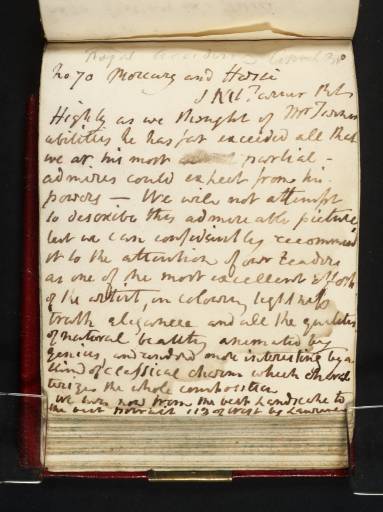Joseph Mallord William Turner Transcript of a Review by John Taylor of 'Mercury and Herse' (Inscription by Turner) 1811
Joseph Mallord William Turner,
Transcript of a Review by John Taylor of 'Mercury and Herse' (Inscription by Turner)
1811
Folio 68 Verso:
Transcript of a Review by John Taylor of ‘Mercury and Herse’ (Inscription by Turner) 1811
D07701
Turner Bequest CXI 68a
Turner Bequest CXI 68a
Pencil and pen and ink on white wove paper, 110 x 88 mm
Inscribed by Turner in pencil and ink (see main catalogue entry)
Inscribed by Turner in pencil and ink (see main catalogue entry)
Accepted by the nation as part of the Turner Bequest 1856
References
1909
A.J. Finberg, A Complete Inventory of the Drawings of the Turner Bequest, London 1909, vol.I, p.301, CXI 68a.
1961
Alexander J. Finberg, The Life of J.M.W. Turner, R.A. Second Edition, Revised, with a Supplement, by Hilda F. Finberg, revised ed., Oxford 1961, p.180.
1980
John Gage, ed., Collected Correspondence of J.M.W. Turner with an Early Diary and a Memoir by George Jones, Oxford 1980, p.48 note 3.
1984
Martin Butlin and Evelyn Joll, The Paintings of J.M.W. Turner, revised ed., New Haven and London 1984, p.81.
1987
John Gage, J.M.W. Turner: ‘A Wonderful Range of Mind’, New Haven and London 1987, p.177.
1997
James Hamilton, Turner: A Life, London 1997, pp.140, 322 note 36.
Turner’s inscription, a copy of a review by John Taylor in The Sun, 30 April 1811, is as follows:
[In pencil] Royal Academy, April 31
[In ink] No.70. Mercury and Herse. J.M.W. Turner, R.A. Highly as we thought of Mr. Turner’s abilities he has far exceeded all that we or his most partial admirers could expect from his powers. We will not attempt to describe this admirable picture but we can confidently recommend it to the attention of our readers as one of the most excellent efforts of the artist, in colouring lightness truth elegance and all the qualities of natural beauty animated by genius, and rendered more interesting by a kind of classical charm which characterizes the whole composition. We now turn from the best Landscape to the best portrait 113 of West by Lawrence
A Tory journalist and proprietor, Taylor was a majority shareholder of The Sun and became its editor in 1817. He was the unofficial press officer of the Royal Academy and a friend of many artists.1 Having called Turner a ‘madman’ on the evidence of his Fall of the Rhine at Schaffhausen (Museum of Fine Arts, Boston, Massachusetts)2 in the 1806 Academy he had since changed his tune. In 1811 he praised Turner’s first four lectures as the Academy’s Professor of Perspective, leading the artist to send thanks – on one occasion poetically3 – and now turned his attention to Mercury and Herse (on the London art market in 2005).4 An undated letter from Turner thanking Taylor for ‘your kindness in the Sun of yesterday’ has been associated by Finberg with this review and dated accordingly to ?May 18115 although as Gage points out, it could also refer to one of the lecture reviews.6 Taylor’s eulogy was repeated in The Morning Post on 2 May.
Doubtless Taylor intended to echo praise by the Prince Regent in his speech at the Academy dinner for ‘landscapes which Claude would have admired’, as this was assumed to refer to Mercury and Herse and created a misleading impression that the Prince intended to buy it. The Prince had recently started to collect modern British art; see notes to folio 65 verso of the sketchbook (D07696) for his purchase of a picture by Edward Bird and commission to David Wilkie in 1810. On 15 May, The Sun reported that two collectors were competing for Mercury and Herse and that Turner preferred not to sell it at all than offend one of them, while on 8 June, Joseph Farington heard that Earl Grey had been ready to pay 500 guineas for it but was put off by the alleged royal interest. Turner was left in an awkward position, reluctant to name a price at all. Reviewing the picture again when it reappeared in Turner’s Gallery in 1812, Taylor regretted that it was unsold, leaving the artist the ‘victim of etiquette and delicacy’.7 Turner eventually sold the picture early in 1813, to Sir John Swinburne for 550 guineas.
The other picture praised by Taylor is Thomas Lawrence’s portrait of the Academy’s ageing President, Benjamin West (Yale Center for British Art, New Haven, Connecticut). In the recent words of Michael Levey it is ‘sober, respectful yet searching’.8
David Blayney Brown
May 2011
How to cite
David Blayney Brown, ‘Transcript of a Review by John Taylor of ‘Mercury and Herse’ (Inscription by Turner) 1811’, catalogue entry, May 2011, in David Blayney Brown (ed.), J.M.W. Turner: Sketchbooks, Drawings and Watercolours, Tate Research Publication, December 2012, https://www

